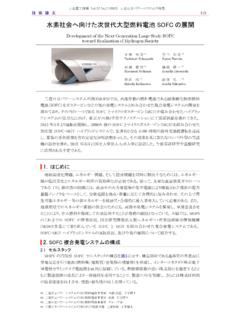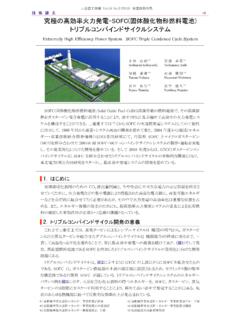Transcription of Submarine Cable Protection - Experience of Hong Kong, China
1 Submarine Cable Protection - Experience of Hong Kong, ChinaMr. Lawrence S M KwanChief Telecommunications EngineerOFTAW orkshop and Information Sharing on Submarine Cable Protection , Security and Prosperity Steering Group, APEC TEL39, Singapore, 13 April 2009 What happened to Hong Kong during the Taiwan earthquake in 2006 Earthquakes struck at 2026H (magnitude ) and 2034H (magnitude ) on 26 Dec 2006 (HKG time) Almost all Submarine cables (connecting Hong Kong to Taiwan, Korea, Japan and the United States) passing through the earthquake region (Luzon Strait) were damaged, resulting in serious disruptions of the external telecommunications services including IDD, roaming services, Internet services and IPLC happened to Hong Kong during the Taiwan earthquake in 2006 (cont.) All IDD services resumed within a few days Internet services were gradually restored Alternative overland routes were activatedHow we recover Improvement after the incident Governmentimproved emergency response system enhanced reporting mechanismOperator to OFTAOFTA to PublicOperator to Publicoffered advicesIssued guidelines to SMEs on how to deal with similar situations in futureadvise the Submarine Cable operators to avoid laying cables in the earthquake regionsImprovement after the incident Government (cont.)
2 Drawn up guidelines on contingency plansGuidelines for Submarine Cable -based operators for Reporting Outagerequested ISPs to provide SMEs with backup and diversity servicescooperated with other Administrationsto formulate long term measuresExplore measures to improve the reliability and resilience of the network infrastructure of Hong KongImprovement after the incident Industry set up contingency plan for backup and diversityOFTA will assess the plans of operator and where necessary give guidanceimproved external Cable capacities and routingsmade use of land cableprovided level of network servicesparticipated in regional cooperationEmergency Response System (ERS) OFTA has established an ERS under which an emergency response team will stand by round the clock and 365 days a yearThe team is to keep in close contact with its counterparts (including all types of operators, relevant Government agencies and overseas administrations) to obtain first hand information about emergency incidents.
3 Purposes of ERSTo prevent, prepare for and respond to network/service congestion and minimize the impact and restore the affected services, if any, as soon as possibleEmergency Response System (ERS) (Cont.) ERS will be activated once network congestion, outage or poor weather happens or anticipated Will ensure that prompt and coordinated response will be taken by the relevant operators to restore the affected services, if any, as soon as possibleEmergency Response System (ERS) managed by OFTAE nhanced Reporting Mechanisms Dissemination of Information to PublicOperators and OFTA have their respective rolesOperators have first-hand information on operational status of their systems and services and should be responsible to provide prompt information and advice to their customers about outagesFor critical/major outages, operators should also report to OFTA under reporting mechanisms. If outage has significant and territory-wide implications, OFTA should alert the public through making warning messages on TV and radioEnhanced Reporting Mechanism (Cont.)
4 More operators are required to report outageOperators concerned are required to report outages of Submarine Cable systems, external telecommunications services and Internet services within a timeframe as prescribed in the relevant Guidelines Reportable Submarine Cable system outage Submarine cables being damaged by anchors dropped from ships, dredging fishing nets, earthquakes or other unknown failures in the backhaul links leading to a loss of more than 50 % of the backhaul capacity of a Submarine Cable system within Hong KongLaw on Protection of Submarine cables Convention for the Protection of Submarine CablesMade at Paris on 14 March 1884 Has became part of the Submarine Telegraph Ordinance (Chapter 497 of Hong Kong Law) under which A person who unlawfully and wilfully breaks or damages any Submarine Cable to which the Convention applies, in such manner as might interrupt or obstruct in whole or in part telegraphic communication, commits an offence and is liable on conviction on indictment to a fine of $500000 and to imprisonment for 5 person who by culpable negligence breaks or damages any Submarine Cable to which the Convention applies commits an offence and is liable on summary conviction to a fine and to imprisonment for 1 measures of operators Selection of suitable Submarine Cable routescable route survey bypass the cliffs and mountains under the sea.
5 New cables not to pass through the Luzon Strait, thus removing one potential single-point failure Selection of suitable Cable landing stationshave little marine traffic to minimise the risk of Cable being damaged by anchors and trawlerswith gently sloping, sandy or silty sea-floors to minimise Cable damagewithout strong currents that would uncover buried cables and potentially move cablesfewer crossings with other Cable /facilitiesProtective measures of operators (Cont.) Protect the cables from shipping, fishing and other activitiesBurial of Submarine cables at 3 - 5 meters deep into the seabed Protect the cables with armouringUsing metallic pipes to protect the cables that are lying along the beaches; Educate the fishermenLiaise with fishermen organizations and provide them with maps and information about the Cable routesAdvise fishermen not to anchor or fish within the Cable route areasContingency plans of operators Improved capacitiesOperators concerned have taken various initiatives to enhance their capacityActivated capacity of external facilities has increased from 698 Gbps in December 2006 to 1,838 Gbps in December 2008, an increase of almost 163% Enhanced Route diversityMulti-ring, diversified network architectureTraffic to be rerouted to alternative segments of the networkInterconnection links between different Submarine cables have been added Capacity of Submarine Cable over the Mainland of China has increased significantly as a backup routeContingency plans of operators (Cont.)
6 Use of land cableLand cables via ChinaLand cables via China for connecting Vietnam, Mongolia, Central Asia and Russiasubmarine Cable landing stations in Shanghai and Qingdao with on-ward connection to international Submarine Cable systems, giving access to South Korea, Japan and North AmericaThe land cables via China provide unique capability and resilience for Hong Kong to connect with the outside worldThere are duplicated routings between HK and China , which improve our resilience furtherContingency plans of operators (Cont.) Contingency ProceduresOperators have tightened up their operational procedure for speedy response in the event of network outage / service disruptionOFTA has vetted the contingency plans and given advice to some operatorsLevel of network services Operators provide different levels of services to meet the business needs of users Companies should choose the appropriate level of service that meet their business needsRoute diversityService provider diversitySite diversityEnhanced service level agreementRegional cooperation Regional cooperation of operators in the region is encouraged to improve the reliability of the regional Submarine Cable infrastructureto pursue cooperation initiative that will pool all available resources at their disposal to deal with major Cable failures that may occur in futureCooperation with other Administrations Administrations would enter into arrangements on
7 Information exchange relating to failure of major Submarine Cable systemsNotification mechanism of such a nature will help secure early warning and first hand information about incidents that may adversely affect our telecommunications servicesidentify what is appropriate at Government level to facilitate the acquisition of adequate backup capacity and route diversityThank You








